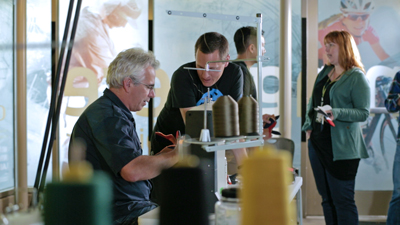The people who decide what the shoes will look like typically bring a different skill set to work than those who decide how to sell the shoes.
It was from that basic, intuitive, somewhat obvious dynamic that the University of Oregon’s new sports product management master’s degree program was born.
Conceived during a strategic planning session at Oregon’s Warsaw Sports Marketing Center in 2012, the program came to fruition in March when it was approved by the state’s higher education commission. It will be based in Portland, where it will tap into experiential and teaching support from many of the leading companies in the sporting goods industry, including Nike, Adidas and Columbia Sportswear.
Unlike students in Oregon’s flagship Warsaw program, graduates will not receive an MBA. Tuition for the 18-month MS track is about $65,000 for in-state students and $75,000 for out-of-state students. Applicants must have at least two years of work experience, preferably with a sports product company.
 |
Students will design prototypes and then construct them at innovation labs.
Photo by: University of Oregon |
Headed by Warsaw alumna Ellen Schmidt-Devlin, who spent 27 years as an executive at Nike, the program welcomes its first entering class of 40 students to campus with a boot camp Sept. 9-25. Fall classes start Sept. 28.
Among the areas of study included in the curriculum: product development, management, merchandising, sourcing and costing; materials management; demand planning; factory management; and supply chain management. It’s an array designed to prepare students for business roles on the hard-to-crack product design teams at sporting goods companies.
“The people we’re educating will go on to be involved in the business of creation,” Schmidt-Devlin said. “These people have never had a program to come to. So when a new company comes along, they’re stealing people from Nike and Adidas. It’s a zero-sum game. Our hope is that we’ll be sending people out into those roles at all these companies, and that they’ll be creating their own companies as well.”
Oregon’s highly regarded Warsaw program already is thought of as a pipeline into the sporting goods industry, largely because its proximity to the companies in that segment make them natural providers of speakers, case studies and projects, as well as internships and jobs. About 50 Oregon alumni work at Nike, for example.
But the core of the curriculum and training opportunities in that program are rooted in marketing, not product design.
“We believe we are going after two decidedly different candidates,” said Whitney Wagoner, who recently was promoted to director at the Warsaw Center. “Those folks are product builders and product designers. They’ll be talking about the process we go through to generate a product. How do you build, construct, produce, manufacture and ship? It will all be built around the product itself.
“They are not going to have what we have. They will not have marketing, branding, storytelling at retail or the power of partnerships and athlete endorsements to sell product. That will continue to be what we do.”
Incoming classes will be split between U.S. students and international students, with U.S. students doing their internships with foreign-based companies and international students doing theirs with U.S.-based companies.
Another distinguishing component of the program is an 18-month group project that yields a business plan and product prototype, which are presented in front of industry professionals.
Broken into teams of five, students will design and construct their prototype at innovation and fabrications labs that house an array of sewing machines, a 3-D printer, a heat press and machines used in woodworking and model-building.
They also will design the retail setting for their product. The first class carries an average age of 27, with five years of industry experience, Schmidt-Devlin said. Many have retail backgrounds and want to move to the product side.
“This was a space in the industry that is underserved,” said John Hull, assistant dean for centers of excellence at Oregon’s Lundquist College of Business. “You have product design people but most don’t have business degrees. And the business degree people aren’t designers.
“There’s this whole layer in the sports product area where they need to get business skills into these young product design people so they can be successful managers.”




